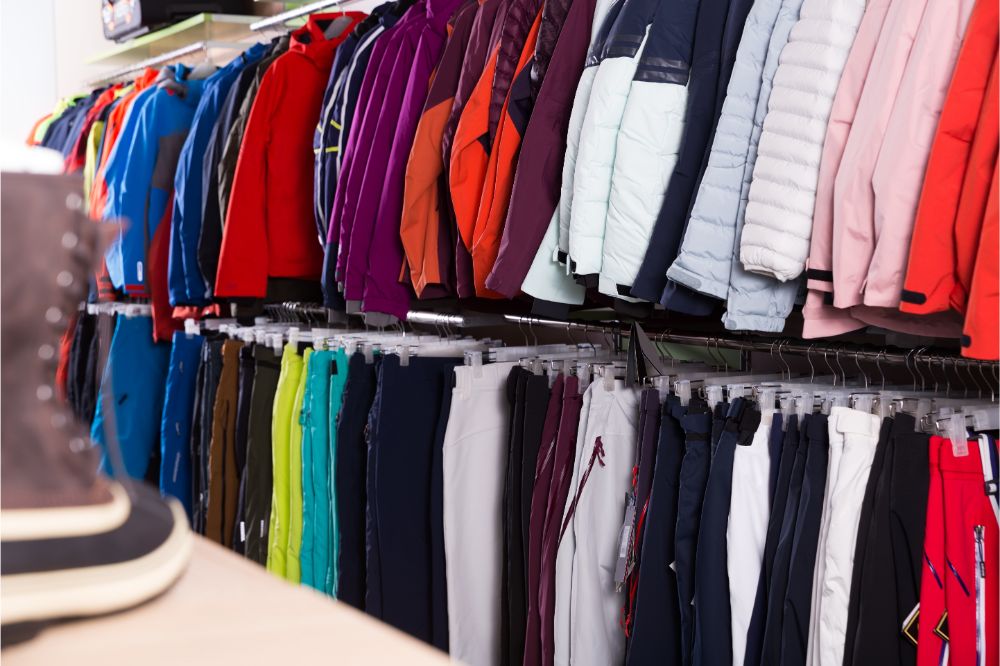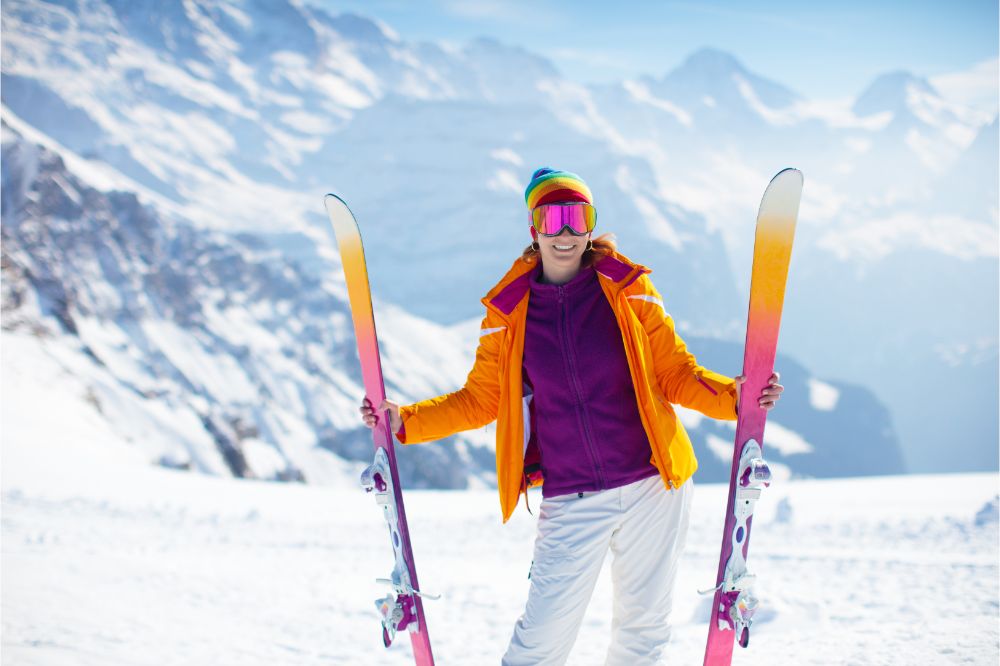It is important to have the right clothes and enough layers to feel warm and comfortable while skiing. You need to apply the layering principle consisting of the base, insulation, and shell layers. This is very important to stay dry and warm over a whole day of skiing.
For this reason, your ski clothes mustn’t fit too tight to allow space for all the layers beneath. The ski clothes should be loose enough to provide free movement while not feeling too bulky with layers underneath.
That is why it is important that your ski clothes are better loose than too tight so you can move freely.

What Are the Functions of Ski Clothes?
Ski clothes are made from special fabrics for a reason and come with various features to fulfill their specific functions. The following is a list of the basic functions you can expect from specialized ski clothing.
To Keep You Warm
The first and foremost function of ski clothes is to keep you warm while moving around in a cold outdoor environment. They are made so that you can wear other layers of garments underneath to keep you warm if it gets too cold.
Protection From the Weather
This specialized clothing has a waterproof capability to stay dry longer and protect you from the weather. This is also why ski clothes are made with a wind-resistant feature to prevent cold wind from cutting through the fabric.
Allow Freedom of Movement
As mentioned before, your ski clothes mustn’t hamper your movements while skiing; they must allow freedom of movement. This includes while you are wearing layers under your ski jacket and pants on colder days in the snow.
The Principle of Layers in Detail
Let’s talk about this layering principle in detail and how to apply it for the best results while skiing outdoors. The main advantage of layered clothing is to compensate for the fluctuation in the weather conditions while you are moving around.
But how do such thin layers actually work to keep you warm?
The insulation work is achieved by trapping a thin layer of air between the different layers of clothing. Since air is a relatively poor conductor of heat, each of these layers of air keeps you warm accordingly. On the other hand, this also means that you can “control” how warm you want to be dressed by the number of layers.
So let’s have a deeper dive in the main purposes of each layer.
First Layer
This layer is also called the base, inner, or transportation layer, which is the closest to your body. This base layer includes clothing such as underwear, socks, and inner gloves. They are mostly made from synthetic materials like cotton polyester that help to trap body heat for the best results.
Second Layer
Also known as the insulation or middle layer, the second layer will transfer moisture and cold further away from your body. This should be thicker clothing as the air that is contained in this clothing functions as insulation in addition to the air layer between the first and second layer.
These clothes can be removed if it gets warmer and you don’t need much protection against milder weather conditions.
Third Layer
This is the top layer. Some may know it as the outer or protection layer, and it must have a wind- and waterproof capability. This layer should also be made from breathable fabric and protect against moisture, which is also why it is called the shell.
For the garment to handle all these features, it should be made from a membrane fabric such as Helly-Tech or Gore-Tex.
See this video for the technical explanation of the different layers and their respective functions.

Some Tips on Layering Clothing
The following hints and tips will help make your life a bit easier while skiing out there for many hours.
- When getting dressed for skiing, make sure that you are not already too warm before you start.
- You will get warm after skiing for a few minutes, so it is better to feel a bit cold before starting.
- If you tend to have cold feet, take a pair of spare socks with you so that you can make sure that you can change them when you feel them to be wet. However, we prefer to only wear one pair of Ski Socks at the time, as otherwise either the boots tend to start hurting or the risk for blisters increases. If you really have cold feet most of the time, try to wear a pair of really thin Nylon Socks under the Ski Socks.
- Buy your garments one piece at a time instead of everything in one go so you can sense which feels and wears the best.
Other Benefits of Ski Clothing
You can enjoy many benefits with ski clothing apart from keeping you warm and protecting against the weather.
- Ample storage for other items that are not carried in a backpack or if you don’t take one with you. This includes such things as a map of the ski area, sunglasses, nose cloth, candies and other snacks, synthetic cloth for goggle cleaning, and more.
- Added protection against nature and the environment is another of the several benefits of wearing the right ski clothes. This means you will be protected against branches that may scratch you and tear your clothing and other types of hazards.
- Having the right ski clothing available will make skiing much more fun and you will enjoy the experience much more.
Questions Often Asked
In this section, we address some questions asked regularly by beginners and those with some experience in outdoor skiing.
Is it Better to Have Tight or Loose Ski Pants?
Your ski pants should not be too tight, so you can have freedom of movement and wear layers underneath. So, it is better if your ski pants are a bit loose than too tight, which will prevent freedom of movement while skiing. Additionally, more loose pants are warmer as they provide an insulating layer of air between your skin and the pants.
Should I Wear Something Underneath My Ski Pants?
It is better to have some or all of the layers under your ski pants depending on the weather conditions where you are skiing. The colder it is, the more layers will be needed under the ski pants. However, we seldom wear more than one layer of thermals under the ski pants.
But what to do if it then gets too hot?
Most of the ski pants do have zippers in the area of the tights. These zippers enables to “open” the pants so that you can let some cool air in. Just do not forget to close the zippers again before going downhill.
Are Leggings a Good Base Layer for Skiing?
You can wear this type of leg attire under your ski pants, but it is better if they are made from synthetic materials. Unfortunately, leggings will not be as warm as the dedicated thermal fabrics, so you should wear thermals when it is very cold outside.
Conclusion
It is obvious that loose ski clothes are better than when they fit too tight for the sole benefit of free movement while skiing. Another positive feature of looser ski clothes is that you can easily add more layers underneath them to keep you warm and cozy.
Hopefully, this information will help you make the right choice when buying ski clothes for your next skiing adventure!






